Key Points:
- Many nonvenomous snakes have evolved to look like coral snakes to avoid attack from predators. Coral snakes have some of the strongest venoms globally, but it’s a challenge for them to bite humans, as their fangs are tiny.
- Cottonmouths (water moccasins) tend to keep their entire bodies on the surface of the water when swimming, but it’s not a reliable identifier.
- Copperheads and cottonmouths can reproduce asexually through a process called parthenogenesis.
- The venom of a rattlesnake is strong enough to destroy tissue and prevent blood from clotting. About 8,000 people in the United States are bitten by rattlesnakes each year, but with only about five fatalities per year.
We all want to avoid venomous snakes, especially the most dangerous ones that can easily take down a human with one quick bite. Venomous is not the same as poisonous, as poisonous implies a transfer of toxins from eating or touching. Venom must be delivered from the snake to a person through a bite.
The four main types of venomous snakes in the United States are coral snakes, cottonmouths, copperheads, and rattlesnakes. This article will take a closer look at these four snakes, so we can understand why they’re regarded as the most venomous snakes in the United States.
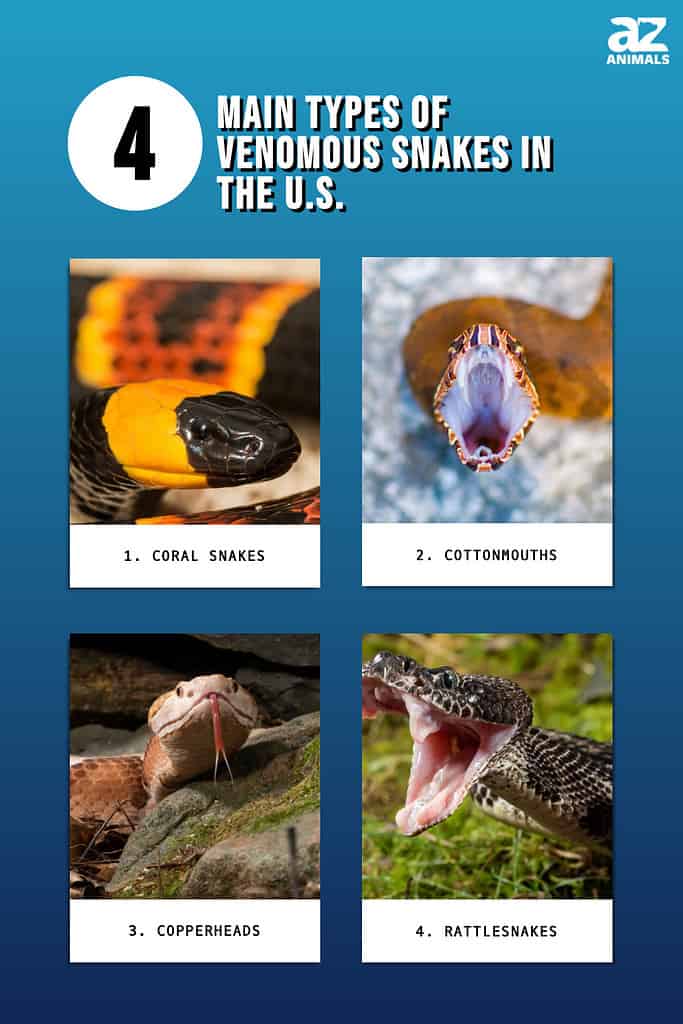
Where in the United States Do Venomous Snakes Live?
The United States is home to about 30 species of venomous snakes, all considered coral snakes, cottonmouths, copperheads, and rattlesnakes. Of those, there are more rattlesnakes, with 23 species found in the U.S. Nearly every state has at least one venomous snake species. The only states free of these threatening creatures are Alaska, Hawaii, Maine, and Rhode Island.
1. Coral Snakes

Coral snakes have some of the strongest venom in the world.
©Jay Ondreicka/Shutterstock.com
The coral snakes found in the United States are New World snakes, and there are far more New World coral snakes than Old World. However, only a few of them are found in the United States. These are the eastern, western, and Texas coral snakes.
There are many snakes that look like coral snakes as an evolutionary tactic. The nonvenomous snakes have disguised themselves as coral snakes to avoid predation.
Every different type of coral snake looks a little different, but they all have bright-banded colors in common. These colors warn predators that they can pack a venomous punch.
There is a famous rhyme to help people know if the snake they’re looking at is a coral snake. It goes, “Red touch yellow, kill a fellow; red touch black, good for Jack.” While this doesn’t apply to snakes outside of the United States, it can help confirm the identity of a typical eastern or Texas coral snake.
Coral snakes are the only venomous snakes in North America that lay eggs.
How Coral Snakes Deliver Venom and What it Does
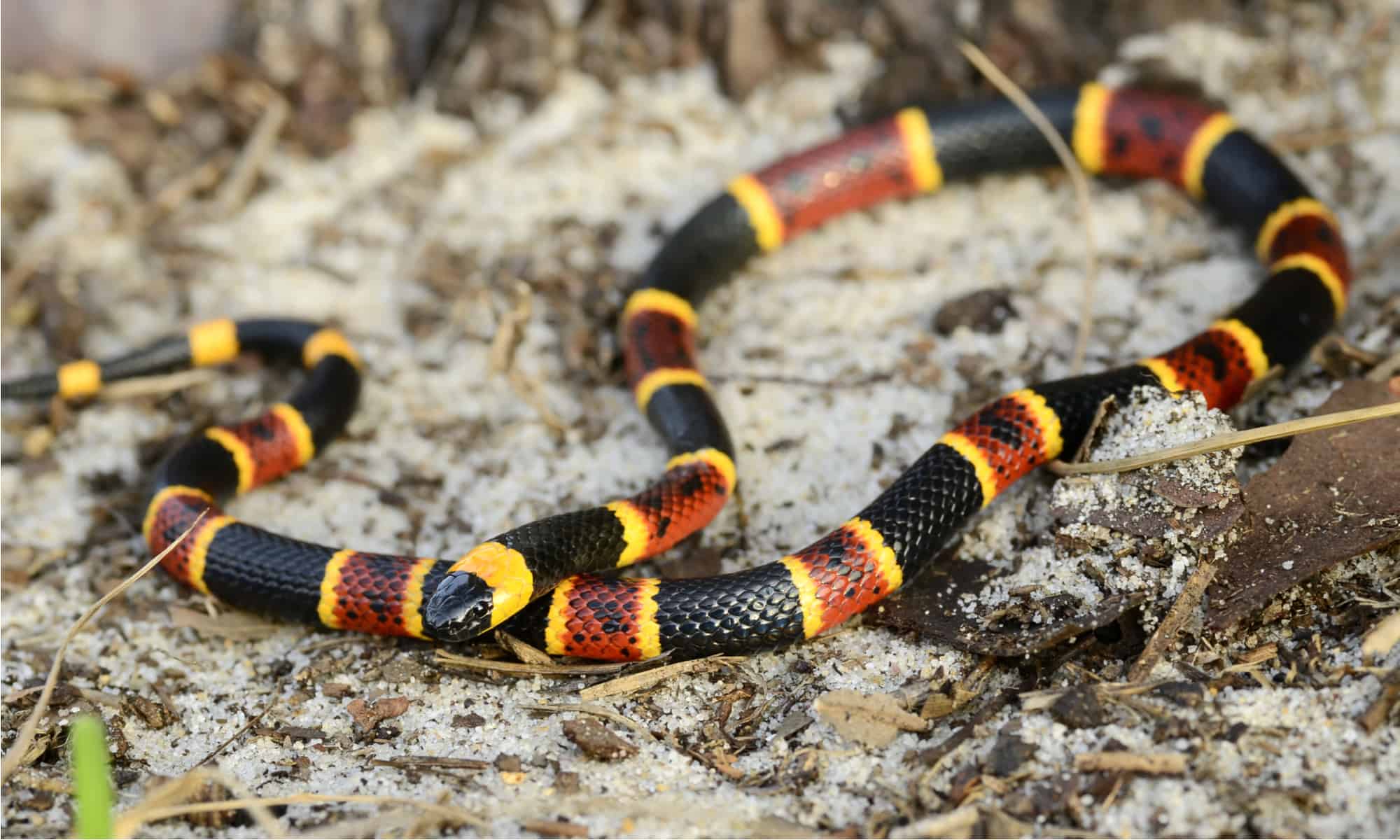
Eastern coral snakes
(Micrurus fulvius)are not as dangerous as copperheads or rattlesnakes because of their venom delivery.
©Patrick K. Campbell/Shutterstock.com
Coral snakes have some of the strongest venoms globally, but it’s not easy for them to bite humans. These snakes have tiny fangs that can’t retract, though these fangs are still sharp. They don’t deliver a lot of venom in one bite, which sometimes keeps the venom from being fatal.
They’re not as dangerous as copperheads or rattlesnakes because of their venom delivery. Over 90% of people these snakes have bitten were trying to handle them.
Contrary to the myth, a coral snake does not have to chew its prey. They bite and hold on to their prey, which is a common behavior among snakes that eat snakes. Cobras do this too, and it seems that it’s more likely an escape-prevention strategy. Nonetheless, the minuscule size of a coral snake’s teeth makes it difficult to puncture human skin, let alone leather boots or denim jeans. If it’s successful in biting you, the strong neurotoxins cause respiratory failure and paralysis. This neurotoxin blocks certain neurotransmitters, which leads to the cascade effect that causes physical symptoms.
When a coral snake lands a bite, it’s important to seek immediate medical attention. An untreated bite is not only painful, but it can also cause cardiac arrest and paralysis of the muscles. Interestingly, coral snake bites don’t cause localized tissue damage or injury.
It takes a few hours for the symptoms of a coral snake bite to begin. Sometimes it can take up to 12 hours, but when the symptoms start, they are severe. There may be slurred speech, double vision, shock, paralysis, convulsions, and other indicators that antivenom is needed immediately.
Even if you’re not sure a coral snake bit you, seek help just in case. There are other snake species that look like coral snakes, like the milk snake, scarlet king snake, and Sonoran shovel-nosed snake. These snakes are non-venomous, but it’s better to be cautious when dealing with the possibility of venomous bites.
2. Cottonmouths
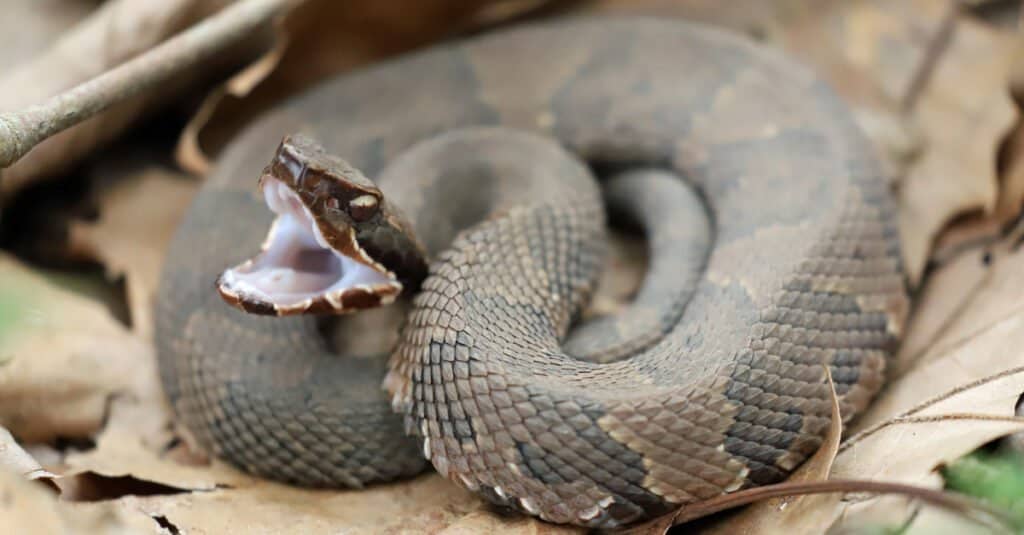
Cottonmouths will strike both on land and in water.
©KF2017/Shutterstock.com
Cottonmouths are also known as water moccasins. They’re called cottonmouths because the inside of their mouth is white like cotton.
These carnivorous pit vipers live up to 25 years and have reached as big as 6 feet long, although they’re more commonly about 4 feet in length. They call the southeastern United States their home and live mainly in the swamps, floodplains, bays, lakes, and wetlands of the region.
These snakes love to swim and spend a lot of time in the water. They stretch from Florida to Texas, and there are two kinds of cottonmouths in the United States. These are the northern cottonmouths and the Florida cottonmouths.
A female cottonmouth doesn’t need a male because it can also produce offspring via asexual reproduction. The use of asexual vs. sexual reproduction eliminates the chance for genetic diversity.
The fear of cottonmouths drives many well-meaning people to kill snakes that look like cottonmouths but are harmless. There are some key differences that distinguish cottonmouths from other similar-looking snakes. For example, water moccasins tend to keep their entire body on the surface of the water while swimming. While that’s not always reliable, it helps narrow down the species because you can see it more clearly.
Cottonmouths and other venomous pit vipers have cat-eye pupils. Since cottonmouths are pit vipers, they have pits between their nose and eyes. Other snakes do not have this feature.
Cottonmouth Venom and the Warning Signs
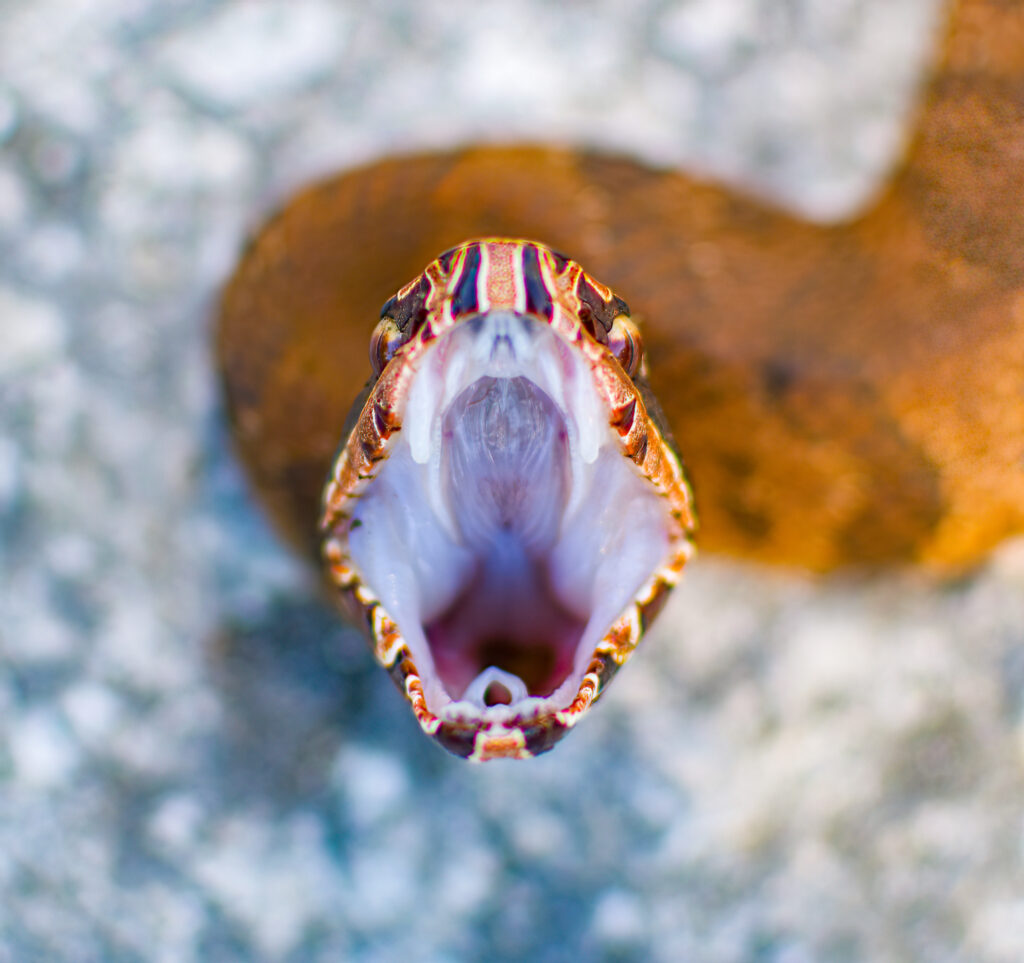
The cottonmouth will shake its tail, raise its head and open its mouth before biting.
©iStock.com/Chase D’animulls
North America has one venomous water snake, and it’s the cottonmouth. This snake will bite both on land and in water.
The venom of cottonmouths destroys tissues, causing excruciating pain and swelling. These snakes aren’t as venomous as rattlesnakes, but they’re considered a bigger threat than copperheads.
There is an antivenom available, and while these bites usually aren’t fatal, immediate medical treatment is needed if you’re bitten by a cottonmouth. Cottonmouths release less venom in self-defense than they do against prey, but that doesn’t mean a bite should be taken lightly.
Cottonmouths don’t go out of their way to attack humans as they’d rather run away. Only 1% of snake wound fatalities are attributed to cottonmouths.
Before it tries to bite, the cottonmouth warns of its threat by shaking its tail, raising its head, and opening its mouth. It’ll also release a musk that’s unmistakably unpleasant.
3. Copperheads
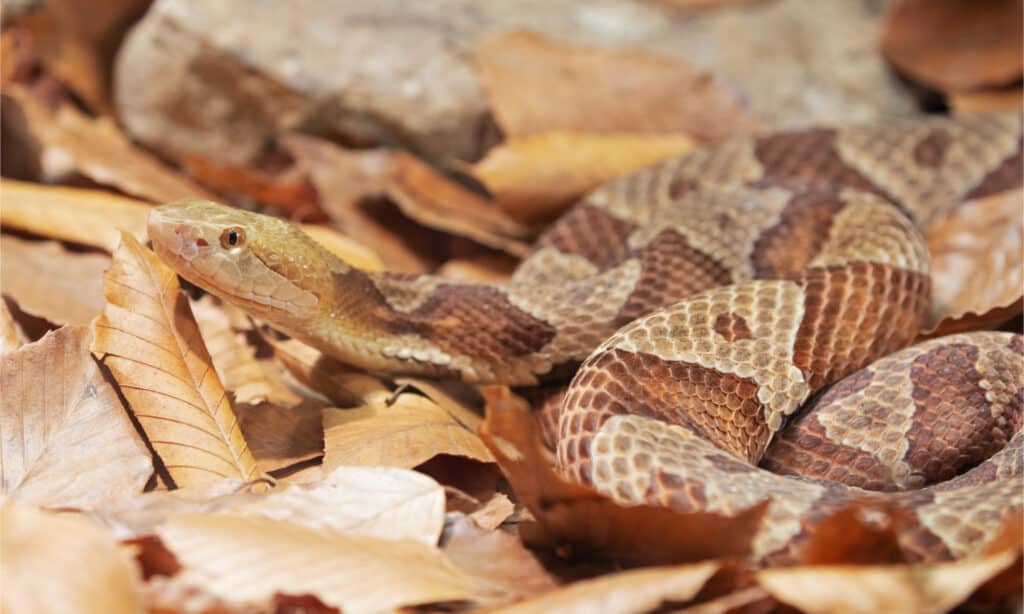
Copperheads’ big triangular heads and cat-eye pupils mark them as venomous.
©DnDavis/Shutterstock.com
Copperheads are brownish-copper in color, which has led to their name. Like most snakes, copperheads use their tongue to help smell for prey that might be around. There are a lot of nonvenomous snakes that look like copperheads, but their big, triangular heads combined with cat-eye pupils give them away as venomous.
There isn’t much genetic difference between a copperhead and a cottonmouth, but they are distinctly different snakes. Unlike the coral snake, the copperhead has a coloration that helps it blend into its natural surroundings.
Like the cottonmouth, this snake can undergo asexual reproduction through a process called parthenogenesis. Copperheads are found in northern Mexico and Texas to Georgia and Massachusetts. They live near bodies of water like lakes and streams.
It’s tempting to exterminate a population of copperhead snakes, but they do have many benefits. They consume large quantities of insects and rodents, which provides pest control. While copperheads aren’t aggressive toward humans, due to their habitat and how well they blend in with the surroundings, copperheads do account for the majority of venomous snake bites in most of their range. For example, in North Carolina, 90% of venomous snake bites come from copperhead snakes.
Copperhead Venom

The copperhead, while venomous, is not considered as venomous as the cottonmouth.
©Creeping Things/Shutterstock.com
Copperheads are dangerous, but they’re not considered as venomous as cottonmouths. Opossums and kingsnakes appear to be immune to their venom. There are a little fewer than 3,000 reported copperhead bites every year. That leaves them at about 40% of the venomous snake bites that occur in the United States each year.
Copperheads deliver a hemotoxin in their venom. This means red blood cells are destroyed. Few people have died after a copperhead bite because the venom is considered weaker than some of the other contenders on this list.
When biting out of self-defense, this snake is known to do what’s called a dry bite. That means that hardly any venom (if any at all) is delivered during a warning strike. However, copperhead venom is strong. It causes terrible pain, swelling, nausea, and tingling and can destroy bone and tissue in the extremities.
4. Rattlesnakes
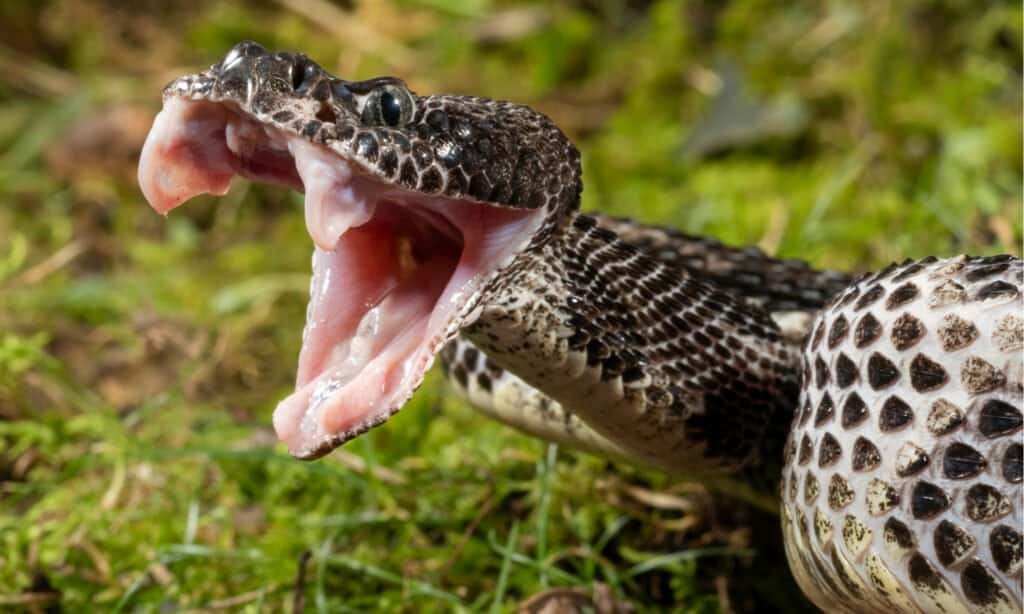
A rattlesnake’s venom subdues its prey before it is swallowed.
©Joe McDonald/Shutterstock.com
Up to seventy species and subspecies of rattlesnakes span from Argentina to southern Canada. In the United States, they can be found almost anywhere, but typically reside in the Southwest. The various types of rattlesnakes can live in grassy areas, mountains, or deserts.
Their rattles are made of chambers that rattle together when the snake shakes its tail. While the rattle gets damaged in a rattlesnake’s natural environment, it gains a segment every time a skin is shed.
The color of these snakes varies by region, but generally, their appearance makes it easier to blend in to avoid predators. They have triangular heads, thick bodies, and have scales in colors like gray, black, brown, yellow, or olive. Their scale patterns are diamond-shaped, banded, or spotted.
Unlike cottonmouths, rattlesnakes aren’t aquatic. However, they will swim and have even been spotted in the ocean swimming to reach new islands.
Rattlesnakes are strict carnivores, and they only need to eat every 2 to 3 weeks. They typically feed on rodents, amphibians, lizards, birds, and insects.
Rattlesnake Venom and Their Defensiveness
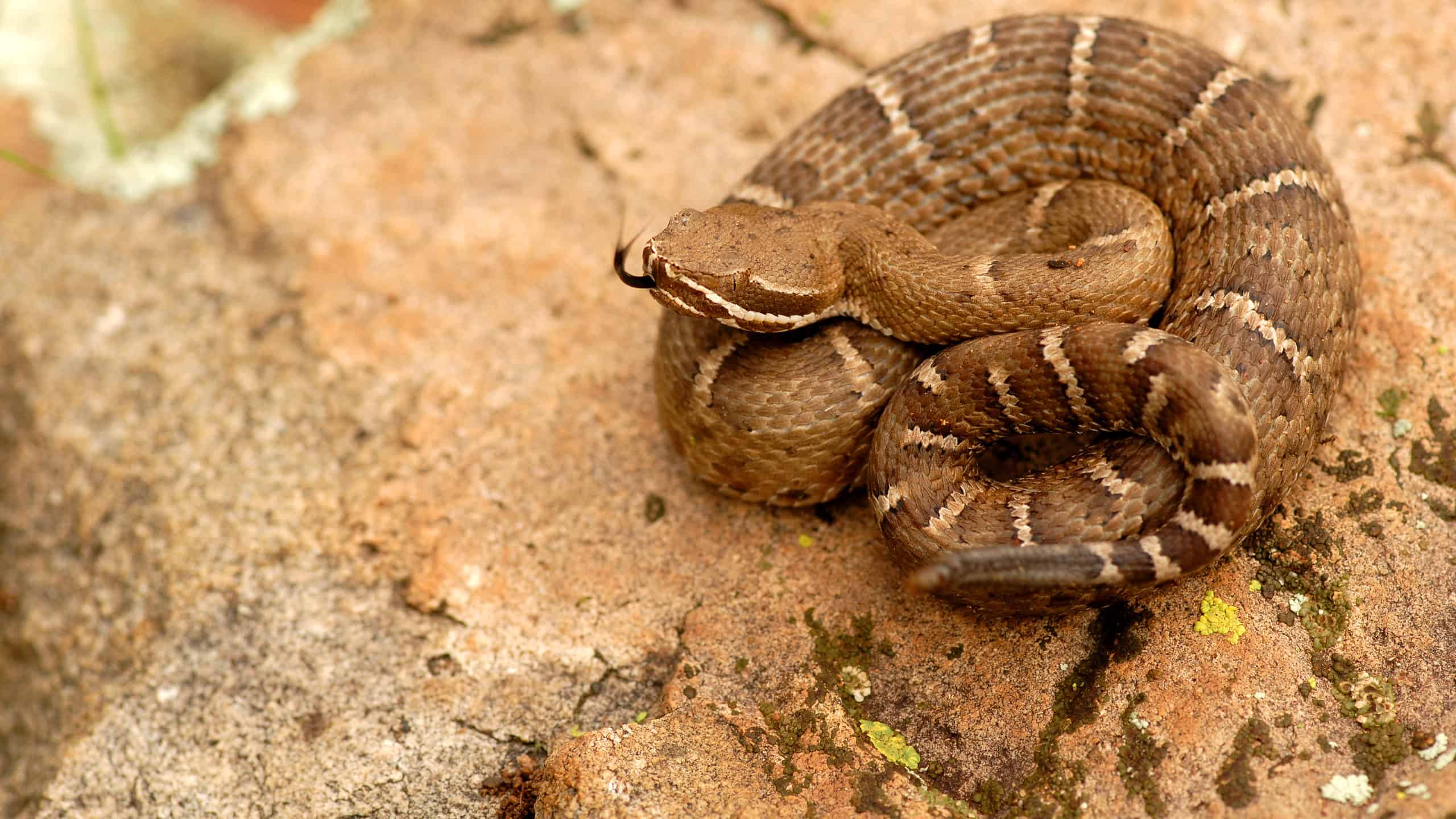
The rattlesnake’s venom is powerful enough to destroy tissue and stop blood from clotting.
©Rusty Dodson/Shutterstock.com
The prey of a rattlesnake begins breaking down before they’re even swallowed. Their venom is powerful enough to destroy tissue and stop blood from clotting. While an antivenom exists, a rattlesnake bite can result in death if it’s not quickly available.
Rattlesnakes aren’t looking to fight with humans but try to hide from them. If they bite, it’s defensive only. Frequently, hikers or adventurers come across well-camouflaged rattlesnakes and do not heed the snake’s warnings. About 8,000 people across North and South America are bitten by rattlesnakes every year, though this only results in about five fatalities per year.
Rattlesnakes can also control the amount of venom they use when they decide to bite something. Depending on which rattlesnake you encounter, they can vary from 1 to 8 feet long. The tiger rattlesnake that resides in Arizona, Mexico, and California is one of the top 10 most venomous snakes in the world.
Summary of the 4 Main Types of Venomous Snakes in the U.S.
Here’s a recap of the four types of venomous snakes found in the United States that we took a look at:
| Traits | Coral | Cottonmouth | Copperhead | Rattlesnake |
|---|---|---|---|---|
| Region | Southern coastal plains | Southeast | Southeast, Northeast, Midwest | Nationwide |
| Habitat | Wooded or marshy areas | Wetlands, lakes, streams, marshes, swamps | Bodies of water like lakes or streams | Grassy areas, mountains, deserts |
| Appearance | Bright-banded colors | Pits between nose and eyes; cats eye pupils; swim on surface of water; bright white mouth | Brownish-copper color; banded scales; cats eyes | Thick bodies; black/brown/gray/olive keeled scales in banded/diamond/spotted patterns; rattle at end of tail |
| Venom | Powerful venom, but tiny non-retractable fangs limit ability to bite humans | Causes terrible pain and swelling; venom destroys tissue; venom more toxic than a copperhead | Hemotoxin venom that destroys red blood cells; few humans die, but venom causes extreme pain, nausea, swelling, tingling; gives warning dry bite first | Bite defensively; venom destroys tissue and stops blood clotting; human death can result if antivenom not readily available |
Lifespan: How Long Do Venomous Snakes Live?
Most snakes live an average of 2-8 years in the wild. In captivity, these numbers can double. Venomous snakes tend to live longer. The copperhead can live up to 18 years in the wild, which is quite long. Cottonmouths, however, are lucky to make it 10 years. The coral snake can live 10-15 years. The rattlesnake has the longest lifespan of 10-25 years.
Other Reptiles Found in the United States

Of the 205 species of lizards found in the U.S., the Gila monster is the only venomous lizard.
©Vaclav Sebek/Shutterstock.com
The United States is home to more than 500 species of reptiles, of which 205 species are lizards. The Gila monster is the only venomous lizard found in this country. It is native to the southwestern United States, as well as northwestern Mexico, and is a heavy, slow-moving reptile with venom that is as toxic as a western diamondback rattlesnake. Only a small amount of venom is injected into its prey (or victim) and there is no antivenom for their bites.
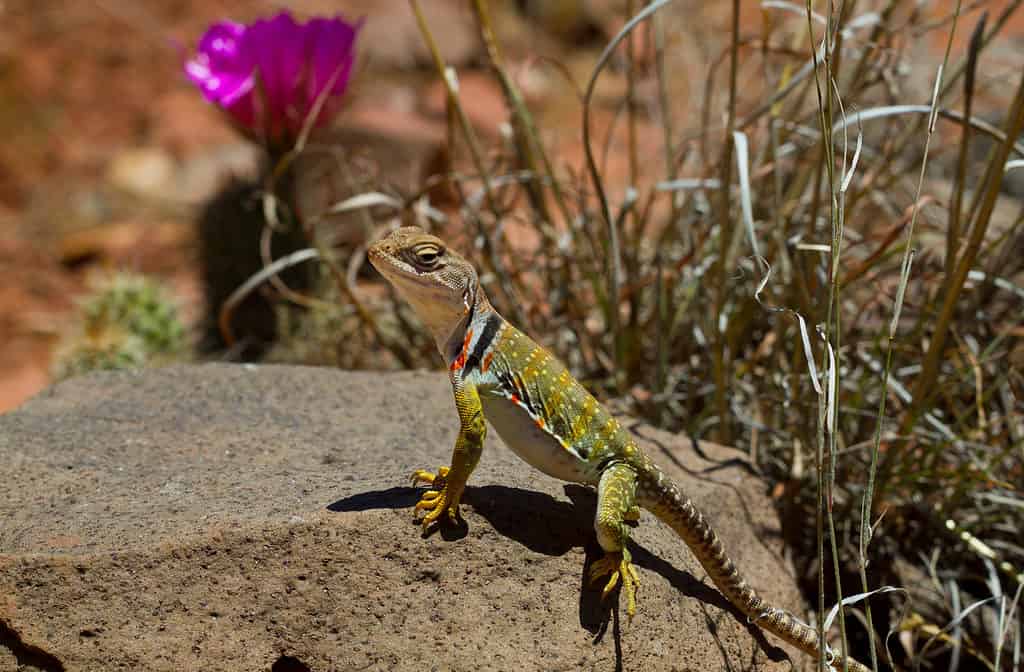
Male eastern collared lizards, also known as the yellow-headed collared lizard, are colorful.
©Patricia Bouweraerts/Shutterstock.com
The eastern collared lizard, widespread throughout the United States, is also known as the yellow-headed collared lizard and the common collared lizard. It is a colorful, long-tailed lizard distinguished by the two black collars around its neck. The males are colorful, while the females range from brownish-green to pale light green. Although not poisonous, they can inflict a painful bite that will break the skin.
The photo featured at the top of this post is ©
Discover the "Monster" Snake 5X Bigger than an Anaconda
Every day A-Z Animals sends out some of the most incredible facts in the world from our free newsletter. Want to discover the 10 most beautiful snakes in the world, a "snake island" where you're never more than 3 feet from danger, or a "monster" snake 5X larger than an anaconda? Then sign up right now and you'll start receiving our daily newsletter absolutely free.
Thank you for reading! Have some feedback for us? Contact the AZ Animals editorial team.






